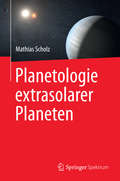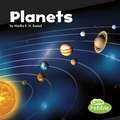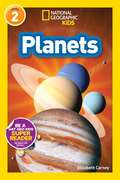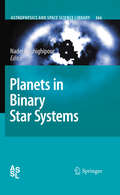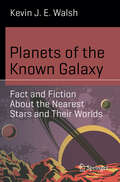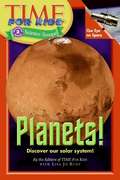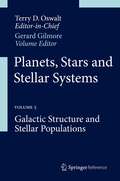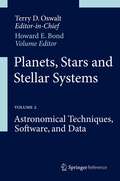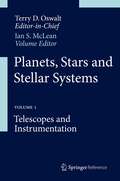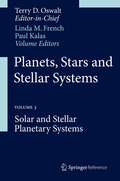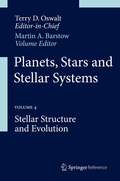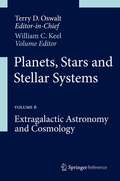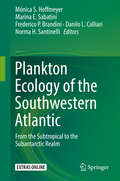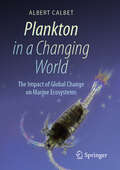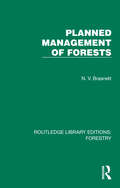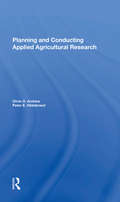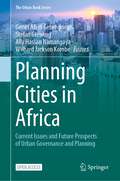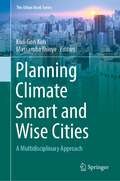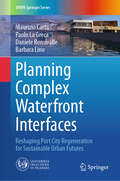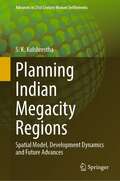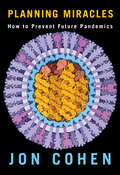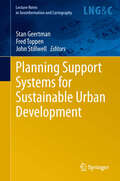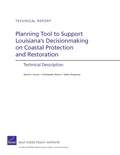- Table View
- List View
Planetologie extrasolarer Planeten
by Mathias ScholzAls im Jahre 1995 die Schweizer Astronomen Michel Mayor und Didier Queloz die Entdeckung des ersten extrasolaren Planeten um einen sonnenähnlichen Stern bekanntgaben, konnte noch niemand ahnen, daß sich daraus in den folgenden knapp zwei Jahrzehnten eine neue, nicht nur in ihrer Entwicklung atemberaubende neue Disziplin der Astronomie entwickeln würde. Zum gegenwärtigen Zeitpunkt (2013) findet man in den Katalogen der Astronomen mittlerweile fast 1000 bestätigte und über 3500 „Exoplanetenkandidaten“ – insbesondere Dank der unerwartet erfolgreichen Mission des leider im Frühjahr 2013 ausgefallenen Kepler-Weltraumteleskops. Es zeigt sich immer mehr, daß Planetensysteme im Kosmos etwas ganz normales sind, die ihrer Natur gemäß eine riesige Formenvielfalt aufweisen. „Heiße Jupiter“, Super-Erden und Pulsarplaneten benennen Objekte, die in unserem Sonnensystem völlig unbekannt sind. Diese exotischen Welten, von denen man meist nur ein paar wenige Parameter kennt, regen nicht nur die Phantasie an, sondern sie befeuern auch die Hoffnung, über kurz oder lang in den Weiten der Milchstraße auch einmal einen Pendanten unseres blauen Planeten zu finden.In diesem Buch werden die wichtigsten Methoden und Erkenntnisse der Exoplanetenforschung so vorgestellt, daß der Leser einen profunden Überblick über diesen neuen Zweig der astronomischen Forschung erhält und in die Lage versetzt wird, die entsprechende Fachliteratur mit Gewinn zu verfolgen. Themen sind die verschiedenen Nachweis- und Beobachtungsmethoden von Exoplaneten, ihre Statistik und Klassifizierung, ihr physischer Aufbau sowie ihre Entstehung, wie er sich den Astronomen aus Beobachtungen und theoretischen Überlegungen erschließt.Das Buch wendet sich an interessierte Studenten der Natur- und Ingenieurwissenschaften, an Abiturienten, Dozenten, Lehrer und nicht zuletzt an Amateurastronomen, die das Wissen über diesen faszinierenden Gegenstand der Forschung mit großer Begeisterung vielen Menschen nahebringen.Mathias Scholz, 1981-1986 Studium der Physik an der Universität Rostock, danach Berechnungsingenieur und ab 1990 freiberuflich auf dem Gebiet der Umweltsimulation sowie im IT-Bereich tätig; Amateurastronom.
Planets
by Martha E. H. RustadDiscover the most important facts about the planets. Simple text and out-of-this-world photographs unlock an early reader’s love of science and learning.
Planets (National Geographic Kids Readers #Level 2)
by Elizabeth Carney Laura MarshThis brilliantly illustrated book taps into children's natural curiosity about the vast world of space. This level two reader, written in simple language that is easy for young readers to understand, introduces children to our solar system, including all of the planets and dwarf planets, and lots of fascinating fun facts. <P><P>This reader helps cultivate the explorers of tomorrow! This high-interest, educationally vetted series of beginning readers features the magnificent images of National Geographic, accompanied by texts written by experienced, skilled children's book authors. The inside back cover of the paperback edition is an interactive feature based upon the book. <P><P> Level 1 books reinforce the content of the book with a kinesthetic learning activity. In Level 2 books readers complete a Cloze letter, or fun fill-in, with vocabulary words.
Planets and Life: The Emerging Science of Astrobiology
by III Woodruff T. Sullivan John A. BarossAstrobiology involves the study of the origin and history of life on Earth, planets and moons where life may have arisen, and the search for extraterrestrial life. It combines the sciences of biology, chemistry, palaeontology, geology, planetary physics and astronomy. This textbook brings together world experts in each of these disciplines to provide the most comprehensive coverage of the field currently available. Topics cover the origin and evolution of life on Earth, the geological, physical and chemical conditions in which life might arise and the detection of extraterrestrial life on other planets and moons. The book also covers the history of our ideas on extraterrestrial life and the origin of life, as well as the ethical, philosophical and educational issues raised by astrobiology. Written to be accessible to students from diverse backgrounds, this text will be welcomed by advanced undergraduates and graduates who are taking astrobiology courses.
Planets and the Solar System
by Keith BrandtWhat are all those things--comets, asteroids, meteorites, planets, moons, sun--floating around among the clouds? This book will tell you that and a whole lot more in an easy-to-read style.
Planets in Binary Star Systems
by Nader HaghighipourThe discovery of extrasolar planets over the past decade has had major impacts on our understanding of the formation and dynamical evolution of planetary systems. There are features and characteristics unseen in our solar system and unexplainable by the current theories of planet formation and dynamics. Among these new surprises is the discovery of planets in binary and multiple-star systems. The discovery of such "binary-planetary" systems has confronted astrodynamicists with many new challenges, and has led them to re-examine the theories of planet formation and dynamics. Among these challenges are: How are planets formed in binary star systems? What would be the notion of habitability in such systems? Under what conditions can binary star systems have habitable planets? How will volatiles necessary for life appear on such planets? This volume seeks to gather the current research in the area of planets in binary and multistar systems and to familiarize readers with its associated theoretical and observational challenges.
Planets of the Known Galaxy: Fact and Fiction About the Nearest Stars and Their Worlds (Science and Fiction)
by Kevin J. WalshThis book offers a tour of “the known galaxy”, here defined as the region of interstellar space closest to Earth. The phrase “the known galaxy” has a particular resonance in science fiction, as it refers to the part of the Milky Way that from the perspective of a point in time centuries from now may have been explored and settled by human beings. In the known galaxy, there are gloomy ocean worlds illuminated by the light of exploding stars. There are worlds where precious gems could be as common as pebbles. There are planets eternally wandering between the stars like the Flying Dutchman. There are lava worlds, steam worlds, hot Jupiters, cold Jupiters and maybe even worlds like our Earth. The purpose of the book is to begin to give this region a sense of place, in the same way that Mars is now starting to be appreciated as a location rather than just a planet. In doing so, the book merges our current scientific knowledge of the known galaxy with speculative fiction and with older legends and myths.A sense of place is the feeling that some locations have a special meaning. This emotional connection arises from a combination of cultural and environmental factors that make individuals care about a particular place. It is challenging to create a sense of place for distant locations that no human has visited and for which our current knowledge is limited. This book attempts to take a step in this direction, by dividing the known galaxy into a number of clearly described distinct regions, by providing scientific descriptions of the likely environmental conditions on the known planets of these regions, and by linking these planets to their literary and mythological context.The book is aimed at fans of both science fact and science fiction. It combines a tour of real planets outside of our solar system with tales of their fictional counterparts. The combination of solid scientific facts and analysis with speculation and imagination will be appealing to readers who want to gain a feeling for these planets as places with a back story, rather than just as names somewhere out there in the sky.
Planets!: Discover our Solar System! (Time For Kids Science Scoops)
by Time for Kids Editors<p>Take a trip around our solar system, Find out how Pluto was named, See amazing snapshots from space & Learn more than forty fun facts about our universe <p>Level 2 includes longer sentences with richer vocabulary, type set line to line to aid readability, varied photographic treatments, and brief chapters with simple illustrated diagrams and a glossary. <p>Special features include How Big?, Take a Close Look, Did You Know?, Words to Know, Fun Facts and full color photographs, as well as a full page, simply labeled diagram showing body parts.</p>
Planets, Stars and Stellar Systems
by Terry D. Oswalt Gerard GilmoreThis is volume 5 of Planets, Stars and Stellar Systems, a six-volume compendium of modern astronomical research, covering subjects of key interest to the main fields of contemporary astronomy. This volume on "Galactic Structure and Stellar Populations", edited by Gerard F. Gilmore, presents accessible review chapters on Stellar Populations, Chemical Abundances as Population Tracers, Metal-Poor Stars and the Chemical Enrichment of the Universe, The Stellar and Sub-Stellar Initial Mass Function of Simple and Composite Populations, The Galactic Nucleus, The Galactic Bulge, Open Clusters and Their Role in the Galaxy, Star Counts and the Nature of Galactic Thick Disk, The Infrared Galaxy, Interstellar PAHs and Dust, Galactic Neutral Hydrogen, High-Velocity Clouds, Magnetic Fields in Galaxies, Astrophysics of Galactic Charged Cosmic Rays, Gamma-Ray Emission of Supernova Remnants and the Origin of Galactic Cosmic Rays, Galactic Distance Scales, Globular Cluster Dynamical Evolution, Dynamics of Disks and Warps, Mass Distribution and Rotation Curve in the Galaxy, Dark Matter in the Galactic Dwarf Spheroidal Satellites, and History of Dark Matter in Galaxies. All chapters of the handbook were written by practicing professionals. They include sufficient background material and references to the current literature to allow readers to learn enough about a specialty within astronomy, astrophysics and cosmology to get started on their own practical research projects. In the spirit of the series Stars and Stellar Systems published by Chicago University Press in the 1960s and 1970s, each chapter of Planets, Stars and Stellar Systems can stand on its own as a fundamental review of its respective sub-discipline, and each volume can be used as a textbook or recommended reference work for advanced undergraduate or postgraduate courses. Advanced students and professional astronomers in their roles as both lecturers and researchers will welcome Planets, Stars and Stellar Systems as a comprehensive and pedagogical reference work on astronomy, astrophysics and cosmology.
Planets, Stars and Stellar Systems
by Terry D. Oswalt Howard E. BondThis is volume 2 of Planets, Stars and Stellar Systems, a six-volume compendium of modern astronomical research, covering subjects of key interest to the main fields of contemporary astronomy. This volume on "Astronomical Techniques, Software, and Data" edited by Howard E. Bond presents accessible review chapters on Astronomical Photometry, Astronomical Spectroscopy, Infrared Astronomy Fundamentals, Astronomical Polarimetry: Polarized Views of Stars and Planets, Sky Surveys,Techniques of Radio Astronomy,Radio and Optical Interferometry: Basic Observing Techniques and Data Analysis, Absolute Calibration of Spectrophotometric Standard Stars,Virtual Observatories, Data Mining, and Astroinformatics, Statistical Methods for Astronomy, Numerical Techniques in Astrophysics . All chapters of the handbook were written by practicing professionals. They include sufficient background material and references to the current literature to allow readers to learn enough about a specialty within astronomy, astrophysics and cosmology to get started on their own practical research projects. In the spirit of the series Stars and Stellar Systems published by Chicago University Press in the 1960s and 1970s, each chapter of Planets, Stars and Stellar Systems can stand on its own as a fundamental review of its respective sub-discipline, and each volume can be used as a textbook or recommended reference work for advanced undergraduate or postgraduate courses. Advanced students and professional astronomers in their roles as both lecturers and researchers will welcome Planets, Stars and Stellar Systems as a comprehensive and pedagogical reference work on astronomy, astrophysics and cosmology.
Planets, Stars and Stellar Systems
by Terry D. Oswalt Ian S. McleanThis is volume 1 of Planets, Stars and Stellar Systems, a six-volume compendium of modern astronomical research, covering subjects of key interest to the main fields of contemporary astronomy. This volume on "Telescopes and Instrumentation" edited by Ian S. McLean presents, after a general Introduction to Telescopes, accessible review chapters on Robotic and Survey Telescopes, Segmented Mirror Telescopes, Honeycomb Mirrors for Large Telescopes, Active Thin-Mirror Telescopes, Optical and Infrared Interferometers, Submillimeter Telescopes, Radio Telescopes, Space Telescopes in the Ultraviolet, Optical, and Infrared (UV/O/IR), CMB Telescopes and Optical Systems, Very- High-Energy Gamma-Ray Telescopes, Instrumentation and Detectors, Silicon-Based Image Sensors, Long-Wavelength Infrared Detectors, and Astronomical Spectrographs. All chapters of the handbook were written by practicing professionals. They include sufficient background material and references to the current literature to allow readers to learn enough about a specialty within astronomy, astrophysics and cosmology to get started on their own practical research projects. In the spirit of the series Stars and Stellar Systems published by Chicago University Press in the 1960s and 1970s, each chapter of Planets, Stars and Stellar Systems can stand on its own as a fundamental review of its respective sub-discipline, and each volume can be used as a textbook or recommended reference work for advanced undergraduate or postgraduate courses. Advanced students and professional astronomers in their roles as both lecturers and researchers will welcome Planets, Stars and Stellar Systems as a comprehensive and pedagogical reference work on astronomy, astrophysics and cosmology.
Planets, Stars and Stellar Systems
by Terry D. Oswalt Linda M. French Paul KalasThis is volume 3 of Planets, Stars and Stellar Systems, a six-volume compendium of modern astronomical research covering subjects of key interest to the main fields of contemporary astronomy. This volume on "Solar and Stellar Planetary Systems" edited by Linda French and Paul Kalas presents accessible review chapters From Disks to Planets, Dynamical Evolution of Planetary Systems, The Terrestrial Planets, Gas and Ice Giant Interiors, Atmospheres of Jovian Planets, Planetary Magnetospheres, Planetary Rings, An Overview of the Asteroids and Meteorites, Dusty Planetary Systems and Exoplanet Detection Methods. All chapters of the handbook were written by practicing professionals. They include sufficient background material and references to the current literature to allow readers to learn enough about a specialty within astronomy, astrophysics and cosmology to get started on their own practical research projects. In the spirit of the series Stars and Stellar Systems published by Chicago University Press in the 1960s and 1970s, each chapter of Planets, Stars and Stellar Systems can stand on its own as a fundamental review of its respective sub-discipline, and each volume can be used as a textbook or recommended reference work for advanced undergraduate or postgraduate courses. Advanced students and professional astronomers in their roles as both lecturers and researchers will welcome Planets, Stars and Stellar Systems as a comprehensive and pedagogical reference work on astronomy, astrophysics and cosmology.
Planets, Stars and Stellar Systems
by Terry D. Oswalt Martin A. BarstowThis is volume 4 of Planets, Stars and Stellar Systems, a six-volume compendium of modern astronomical research, covering subjects of key interest to the main fields of contemporary astronomy. This volume on "Stellar Structure and Evolution" edited by Martin A. Barstow presents accessible review chapters on Stellar Structure, Stellar Atmospheres, The Sun as a Star, Asteroseismology, Star Formation, Young Stellar Objects and Protostellar Disks, Brown Dwarfs, Evolution of Solar and Intermediate- Mass Stars, The Evolution of High Mass Stars, Stellar Activity, White Dwarf Stars, Black Holes and Neutron Stars, Binaries and Multiple Stellar Systems, Supernovae and Gamma-Ray Bursts, and Stellar Winds. All chapters of the handbook were written by practicing professionals. They include sufficient background material and references to the current literature to allow readers to learn enough about a specialty within astronomy, astrophysics and cosmology to get started on their own practical research projects. In the spirit of the series Stars and Stellar Systems published by Chicago University Press in the 1960s and 1970s, each chapter of Planets, Stars and Stellar Systems can stand on its own as a fundamental review of its respective sub-discipline, and each volume can be used as a textbook or recommended reference work for advanced undergraduate or postgraduate courses. Advanced students and professional astronomers in their roles as both lecturers and researchers will welcome Planets, Stars and Stellar Systems as a comprehensive and pedagogical reference work on astronomy, astrophysics and cosmology.
Planets, Stars and Stellar Systems
by Terry D. Oswalt William C. KeelThis is volume 6 of Planets, Stars and Stellar Systems, a six-volume compendium of modern astronomical research, covering subjects of key interest to the main fields of contemporary astronomy. This volume on "Extragalactic Astronomy and Cosmology" edited by William C. Keel presents accessible review chapters on Galaxy Morphology, Elliptical and Disk Galaxy Structure and Modern Scaling Laws, Star Formation in Galaxies, The Cool ISM in Galaxies, The Influence of Environment on Galaxy Evolution, Clusters of Galaxies, Active Galactic Nuclei, Large Scale Structure of the Universe, Distance Scale of the Universe, Galaxies in the Cosmological Context, Evolution of Active Galactic Nuclei, The Intergalactic Medium, and Cosmic Microwave Background. All chapters of the handbook were written by practicing professionals. They include sufficient background material and references to the current literature to allow readers to learn enough about a specialty within astronomy, astrophysics and cosmology to get started on their own practical research projects. In the spirit of the series Stars and Stellar Systems published by Chicago University Press in the 1960s and 1970s, each chapter of Planets, Stars and Stellar Systems can stand on its own as a fundamental review of its respective sub-discipline, and each volume can be used as a textbook or recommended reference work for advanced undergraduate or postgraduate courses. Advanced students and professional astronomers in their roles as both lecturers and researchers will welcome Planets, Stars and Stellar Systems as a comprehensive and pedagogical reference work on astronomy, astrophysics and cosmology.
Plankton Ecology of the Southwestern Atlantic: From the Subtropical to the Subantarctic Realm
by Mónica S. Hoffmeyer Marina E. Sabatini Frederico P. Brandini Danilo L. Calliari Norma H. SantinelliThis book integrates a variety of issues such as regional settings of productivity and nutrient cycling; plankton of coastal and shelf systems; plankton, climate change and human-induced changes; harmful algae and their impacts; and gelatinous zooplankton. This book explores the intriguing marine plankton communities of the SWA region of South America encompassing low to high latitude environments, framed by a complex hydrographic background and global climate change.This vast and iconic region has been largely under-recognized and under-studied. However, in recent years a strong interest has emerged along with the acknowledgment of its high biological productivity. The book concludes by discussing conservation in the region, highlighting regional biodiversity hotspots where the challenges of climate change, habitat loss, and other threats to biodiversity may be particularly acute.Plankton Ecology of the Southwestern Atlantic is a timely synthesis of the field, setting a new baseline for future research. It will be important reading for both researchers and graduate students, and will also be of interest and use to a professional audience of oceanographers, conservation biologists, stake holders and educated science enthusiasts
Plankton in a Changing World: The Impact of Global Change on Marine Ecosystems
by Albert Calbet"Plankton in a Changing World: The Impact of Global Change on Marine Ecosystems" invites readers to explore the microscopic hidden world beneath the waves. This book unravels the fundamental concepts of plankton ecology and their relevance, while exploring the profound impacts of global environmental changes on these vital organisms. Written in a clear and engaging way for the general public, it begins with a foundational overview of plankton, allowing it to stand alone. However, reading "The Wonders of Marine Plankton," from the same author, is encouraged for a deeper understanding of plankton ecology and peculiarities. Plankton form the very foundation of marine ecosystems. As climate change, pollution, and human activities continue to reshape our world, understanding the intricate dynamics of plankton becomes increasingly crucial. This book offers a comprehensive exploration of how these changes influence plankton populations, with far-reaching consequences for marine life and global ecosystems. Addressing issues such as rising temperatures, ocean acidification, pollution, and overfishing, the book highlights the complex challenges plankton face. Regional perspectives and case studies illustrate varied responses across different climates, showcasing the diverse impacts and adaptive strategies. Through engaging prose and rich scientific insight, "Plankton in a Changing World: The Impact of Global Change on Marine Ecosystems" invites readers to appreciate the delicate balance of our ocean and the pivotal role plankton play in maintaining it. Concluding with future research directions, it underscores the need for innovative approaches and public awareness to safeguard these essential organisms. "Plankton in a Changing World: The Impact of Global Change on Marine Ecosystems" is an essential read for those interested in marine life and environmental science. Discover how tiny organisms can have a colossal impact and why their survival is intertwined with the future of our world.
Planned Management of Forests (Routledge Library Editions: Forestry)
by N. V. BrasnettOriginally published in 1953, this book was compiled to provide students of forestry with a simple outline of what the management of forests involves, and of the way in which forestry operations are organized and controlled. Topics discussed and explained include economic considerations, stock mapping, topography, climate, soils, form and distribution of crops, scientific forestry, destruction of forests, regulation by volume, area and size and forest protection.
Planning And Conducting Applied Agricultural Research
by Chris O Andrew Peter E HildebrandThis study focuses on applied research as a service to a client with a problem that research can help solve. Because applied research has a definite purpose, there is usually a time constraint, a deadline by which the work must be completed, as well as a limit on the resources the client has available or is willing to use. Consequently, the researc
Planning Cities in Africa: Current Issues and Future Prospects of Urban Governance and Planning (The Urban Book Series)
by Stefan Greiving Genet Alem Gebregiorgis Ally Hassan Namangaya Wilbard Jackson KombeThis open access book provides insights into challenges, threats and opportunities of urban development in Africa. It discusses how and why African cities need localised urban planning concepts and theories to deal with challenges and threats of rapid urbanisation and climate change. The book delivers an in-depth view of the nature and gaps of the framework on which current planning practice and education in Africa are based. With that, it discusses the potentials of African cities to mobilise local knowledge, resources and capacity building for sustained and resilient urban growth.This work is addressed to educationists and practitioners in the field of urban development management, climate change adaptation and urban resilience. Specifically, such audiences include researchers, spatial planners, graduate students and member of civil societies working on urban development management.
Planning Climate Smart and Wise Cities: A Multidisciplinary Approach (The Urban Book Series)
by Kwi-Gon Kim Massamba ThioyeThis book provides information that facilitates integrated climate actions in cities, leveraging disruptive technologies, business models, policies, financing, and leadership solutions. It fosters the development of climate smart and wise cities. It reviews the major developments of climate actions in cities and combines climate environment and energy technology, policy and financing instruments. A range of distinguished authors assess the experiences thus far and also consider future development from both theoretical and practical perspectives. They also discuss many policy and technical options, including climate smart and wise city planning, inclusion of urban nature, international and national carbon market mechanisms and measuring its impact and digital transformation. Moreover, attention is paid to the role of natural principles, the role of transparency principles and to aspects of democratic climate governance within a climate action scheme. This book makes clear that the carbon neutrality, sustainability, circularity, efficiency, connectivity and resiliency of cities depend to a large extent on the specific digital technologies and the leadership reshaping our cities.Discussing multidisciplinary aspects of climate action, this book offers new insights to academics, policymakers and practitioners both in the public and private sectors. Those insights are not only retrospective, relevant for understanding the past, but they are also prospective and forward-looking, guiding the achievements of the SDGs and the climate goals.
Planning Complex Waterfront Interfaces: Reshaping Port City Regeneration for Sustainable Urban Futures (UNIPA Springer Series)
by Maurizio Carta Daniele Ronsivalle Paolo La Greca Barbara LinoThis book presents a comprehensive examination of the complex interactions between port systems and urban environments, with a particular focus on international methodologies and site-specific case studies from the waterfronts of Palermo and Catania and the West Sicily Sea Authority. It addresses the multifaceted challenges and opportunities inherent in waterfront regeneration, emphasizing the critical importance of developing new urban interfaces that seamlessly connect ports to their surrounding cities. These interfaces serve not only as physical transitions but also as vital cultural and economic linkages that foster community engagement and enhance the liveability of urban spaces. The work offers a series of detailed analyses that highlight the necessity of integrating heritage protection within contemporary urban planning frameworks. By exploring historical developments and current initiatives, it provides valuable insights applicable to diverse global contexts, making it relevant for policymakers, urban planners, and scholars dedicated to understanding the future of port cities. Through rigorous exploration of strategic planning and stakeholder engagement, this book highlights pathways toward innovative solutions that respect historical contexts while advancing sustainable urban futures. By prioritizing the creation of effective urban interfaces, it contributes to the broader discourse on port-city relationships worldwide, underscoring their significance in shaping resilient and vibrant urban environments.
Planning Indian Megacity Regions: Spatial Model, Development Dynamics and Future Advances (Advances in 21st Century Human Settlements)
by S. K. KulshresthaThis book focuses on spatial planning of megacities that are growing in Asia, Africa, and America. These cities are not be seen in isolation from their respective influence regions. They complement each other. Most of the solutions to the problems of such cities are found in their respective regions, and, on the other hand, the regions derive their strength from their respective megacities. There is a need for promoting integrated spatial planning of megacity regions. The five chapters in this book highlight the spatial planning of such regions.
Planning Miracles: How to Prevent Future Pandemics
by Jon CohenA groundbreaking book about the past, present, and future of pandemics, and a behind-the-scenes portrait of the intrepid and innovative community of scientists working tirelessly to stop the next one before it startsIn 1955, the vaccine that eliminated polio was celebrated as a &“planned miracle." Today, despite the astonishing global effort that came together to develop a vaccine for COVID-19 at unprecedented speed, we struggle against the rise of science denial and misinformation. Since 2020, we have had to face a terrifying truth: It&’s not if we&’ll experience another pandemic, it&’s when. How do we prepare?Planning Miracles tells the stories of the committed scientists at the front lines, fighting back against societal distrust and panic, monitoring the threats that exist, detecting outbreaks early, and developing new interventions as quickly as possible. Renowned science reporter Jon Cohen travels from the mountains of Vietnam to the rainforests in the Amazon, from the &“wet&” markets in Cambodia to fairgrounds in the United States, exploring how we can better defend ourselves against the growing threat of pandemics, and he finds surprising—and encouraging—answers. Cohen meets scientists sampling bats, pigs, wild birds, poultry, and insects to hunt for the next dangerous virus. He visits labs developing next-generation vaccines with cutting-edge technology that aim to protect us from entire viral families. Cohen discovers the unexpected links between climate change and the spread of disease and describes efforts to improve the equitable distribution of vaccines, diagnostics, and data sharing around the world.Weaving together history, reportage, and science writing, Planning Miracles is revelatory and necessary—providing hope that if we work together to plan for the next pandemic, we can avoid disaster.
Planning Support Systems for Sustainable Urban Development
by John Stillwell Stan Geertman Fred ToppenThis book collects a selection of the best articles presented at the CUPUM (Computers in Urban Planning and Urban Management) conference, held in the second week of July 2013 in Utrecht, the Netherlands. The articles included were selected by external reviewers using a double blind process.
Planning Tool to Support Louisiana's Decisionmaking on Coastal Protection and Restoration
by David G. Groves * Christopher Sharon * Debra KnopmanA computer-based decision-support tool, called the Coastal Protection and Restoration Authority (CPRA) Planning Tool, provided technical analysis that supported the development of Louisiana's Comprehensive Master Plan for a Sustainable Coast through CPRA and community-based deliberations. This document seeks to provide an accessible technical description of the Planning Tool and associated analyses used to develop the Master Plan.
